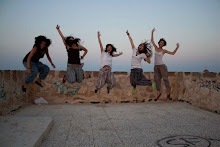During my four and a half years at UC Berkeley, I somehow managed to double major in Public Health and Near Eastern Studies emphasis in Arabic Language and Literature. In the latter, as I was learning Arabic I had taken quite some classes on both ancient and modern Islamic civilizations, impacts, and history. With only one last L&S breadth left to graduate, I decided to complete it through studying abroad in my last summer before starting graduate school.
I somehow had applied to and then switched between three other study abroad programs before I came across Imagining, re-Envisioning the Urban Setting, and ultimately selected this program. And this by far has been probably the most beneficial experience to end my undergraduate career (even despite not being an architecture major), as things I have came across in classes through lectures, textbooks, and research were actualized in person throughout the program. I was able to witness, touch, learn further in depth, and feel a more emotional connections to the various historical Islamic sites we have visited.
My first experience was with the Rabita in Guardamar del Segura. The Rabita is an Islamic monastery that dates back to the tenth century, and is one of the most well preserved ancient Islamic sites in Spain. As Ester, the on-site archeologist, was going in depth describing the site containing about 28 small, basic rooms each with a protruding square thought to be a prayer cell, I thought back to 2016 to Dr. Hatem Bazian’s Sufism class. In this course Dr. Bazian goes in depth on the various orders, historical and modern context of the spread of Sufism throughout the world, including Andalusia Spain. Upon inspecting the remains of these urban spaces, I specifically remembered his descriptions of living quarters of Sufi schools and the lifestyles and practices of Sufi mosques. How in many orders, Sufis would attempt to live very modestly, from the clothes they wore to the quarters they lived in, to avoid any distractions from their worship and love of God. Ester informed us of how the Rabita may have been a site of pilgrimage, as visitors would etched into the walls praises and prayers to God for safe travels. I then recalled how there were students that would travel to schools where they can learn Sufism from certain sheikhs, or the scholars and sometimes founders of certain orders. And I remembered how Sufi scholar Ibn al-Arabi had a very significant influence in Andalusia Spain. I asked Ester if there has been any thought that this could be a site of a Sufi school, to which she confirmed that there have been a few researchers that theorized that. Ester and another archeologist then guides us to the middle of the site in where there is a quote in Arabic on the wall, and they ask if I’m able to read it. It was extremely worn down over the past century, but there were a few words that I was able to read. And although it is premature to declare the Rabita as a site of an ancient Sufi school and far more research needs to continued to be done , even being able to draw on previous knowledge to come to plausible conclusions on the site was indescribable. Through this experience I felt like I had a connection to this (former) urban space, which easily made it my favorite site we visited in Spain; that was until went to Granada.
I had always seen pictures the Alhambra even before I knew of its name or the city it is in, but it wasn’t until I began my studies at Cal though, that I became familiar with Granada, Through numerous mentions, lectures and discussions held in various classes, I learned of different aspects Andalusian history and/or people. But to be able to witness and experience something in person is incomparable to any classroom in this case. While in Granada I was able to visit the Alhambra two days in a row, and on both I rented out an audio guide and attempted to cover the entire site. I noticed immediately how respectful it was in presenting the Islamic history of the site, without utilizing underlying Islamaphobic rhetoric like with our previous tour guide in Valencia did. And I came to realize that it was one of the very few urban spaces that I felt was truly accessible through cultural means — that is as long as you can get a ticket to pass through the entrances. It was apparent that the caretakers of the Alhambra made it so that all felt welcomed and respected through the information they shared, and accomplished presenting information without tokenizing or creating a spectacle of the Muslim community and its history. The impacts of this can be seen through the representation of guests and how they were engaging with this urban space, which I found most intriguing. Out of all of Spain, I saw and/or (over)heard the most Muslims and Middle Eastern/North African (MENA) people in Alhambra, as it seemed that they made up almost half of the guests visiting. And through my own engagement with the space, I overheard countless segments of conversations where visitors would share information and discuss about the space in Arabic, English, and Spanish (and countless other languages spoken there that I do not understand). It was at that moment, that these visitors seemingly blended amongst the rest of the guests as they too were able to experience, explore and enjoy the site and establish a connection to Granada. It was beautiful to be able to witness diversity in a shared experience, and if I could only ever visit Spain again it would be to visit Granada once more.
Yasmeen | ياسمين

No comments:
Post a Comment